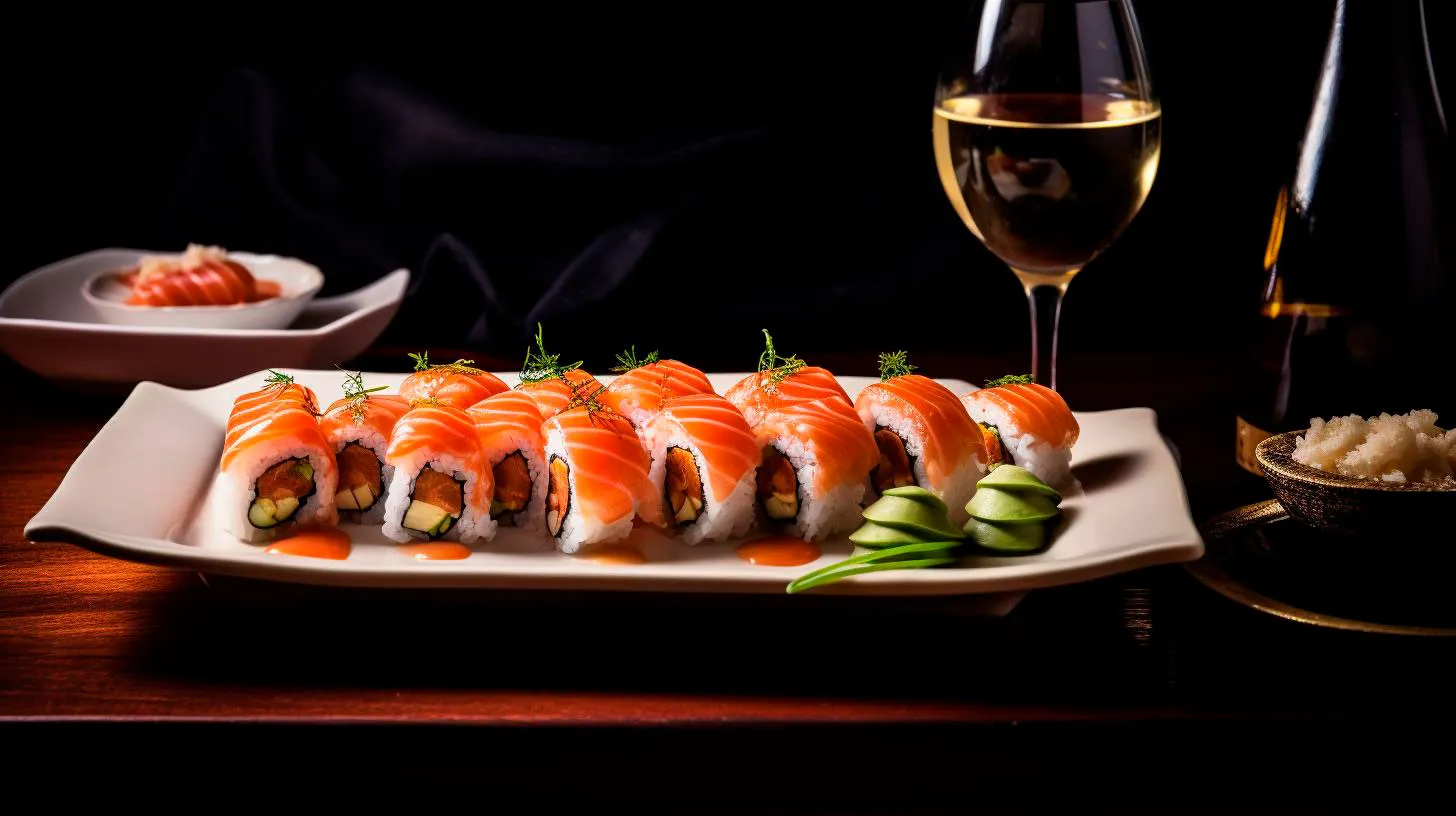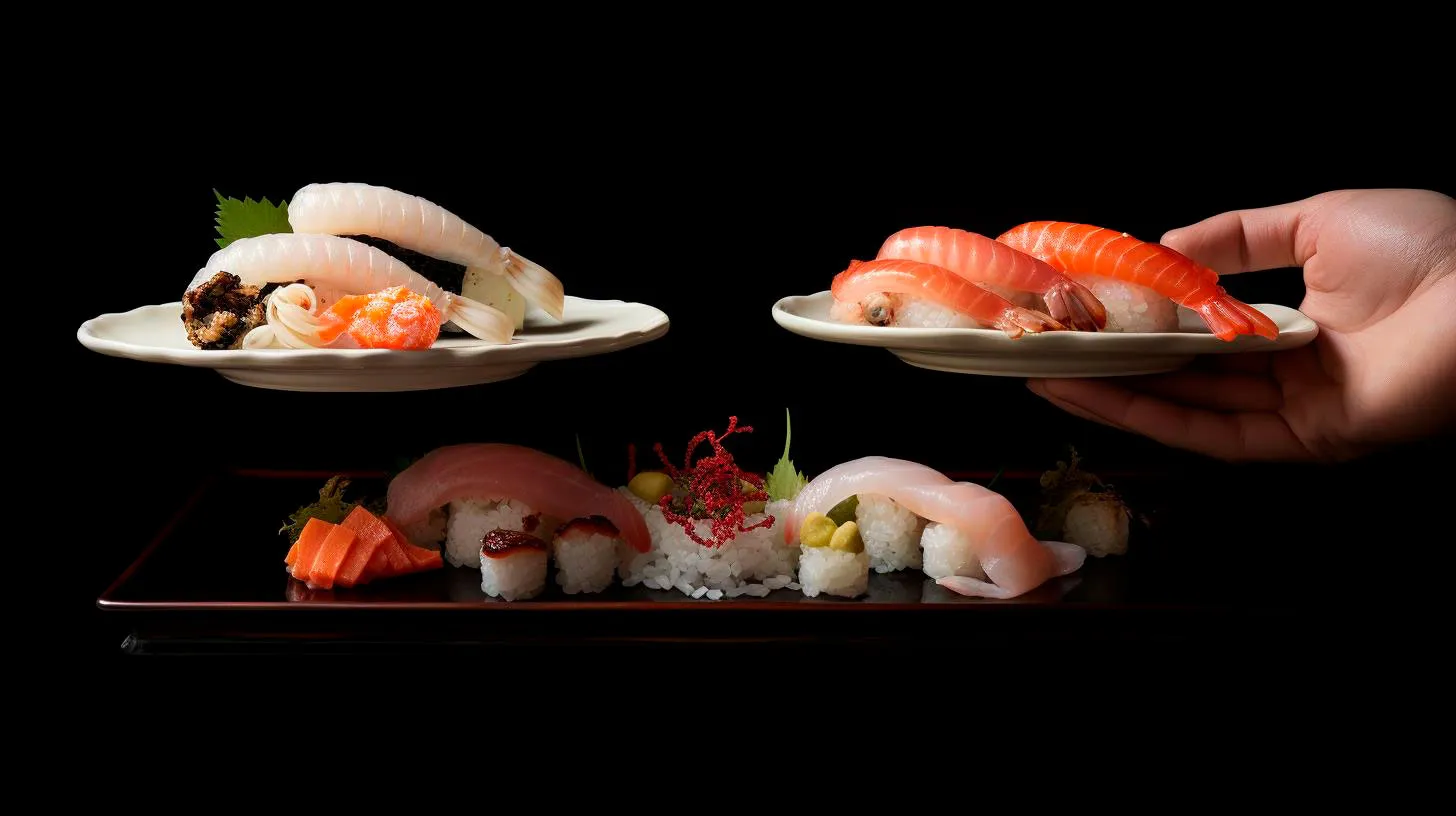The Secrets of Sushi Rice
In this article, we will delve into the secrets of sushi rice, uncovering the techniques and ingredients that make it so special. Whether you are a sushi lover or a curious foodie, understanding the art of sushi rice will enhance your appreciation for this delightful dish.
The Perfect Balance
Sushi rice, also known as shari, is a unique type of short-grain rice that is specially prepared for sushi. It is seasoned with a mixture of rice vinegar, sugar, and salt, which adds a distinctive tangy flavor to the rice. Achieving the perfect balance of sweetness and acidity in the seasoning is crucial for creating delicious sushi rice.
One of the key secrets to making the perfect sushi rice lies in the vinegar used for seasoning. While most traditional recipes call for rice vinegar, some sushi chefs experiment with other types of vinegar, such as apple cider or black vinegar, to add unique flavors to their creations. This allows for endless creativity and taste variations when it comes to sushi rice.
The Art of Cooking Sushi Rice
Creating the perfect texture and consistency of sushi rice requires precise cooking techniques. The rice should be cooked to perfection, where individual grains are tender but still have a slight chewiness to them. Overcooked or mushy rice can ruin the overall sushi experience.
It is important to rinse the sushi rice thoroughly before cooking it. This helps remove excess starch, resulting in fluffy and separated grains. Traditionally, sushi rice is cooked using a rice cooker, but it can also be cooked on the stovetop. The key is to maintain the proper water-to-rice ratio and follow the cooking instructions to achieve the desired texture.
Once the rice is cooked, it needs to be immediately seasoned with the vinegar mixture while it is still hot. As the rice cools, it absorbs the flavors of the seasoning, giving it that much-desired tangy taste.
Key Takeaways for Perfect Sushi Rice
- Choose the right type of rice: Short-grain or sushi rice is essential for creating the perfect texture and consistency.
- Experiment with different vinegars: While rice vinegar is the traditional choice, other types of vinegar can add unique flavors to your sushi rice.
- Master the cooking technique: Properly rinsing and cooking the rice will ensure fluffy, separated grains.
- Timing is everything: Season the rice immediately after cooking to allow it to absorb the vinegar mixture while it is still hot.
A Perfect Partner for Fresh Fish
Sushi rice not only acts as a delicious base for sushi rolls but also serves as the ideal partner for fresh, high-quality fish. The tangy taste of the rice complements the rich flavors of the fish, creating a harmonious and satisfying flavor profile.
When preparing sushi, the rice is often topped with raw fish or seafood. This combination of rice and fish is what gives sushi its unique identity and exquisite taste. The quality of the fish is just as important as the rice, as only the freshest and finest ingredients can truly elevate the sushi experience.
Key Takeaways for Sushi and Fish Pairing
- Choose fresh fish: Opt for sushi-grade fish that is sourced from reputable suppliers.
- Explore a variety of fish: From salmon to tuna, there is a wide range of fish options available for sushi lovers to explore.
- Experiment with different toppings: Aside from raw fish, sushi can also be topped with cooked seafood, vegetables, or even fruit for a creative twist.
Conclusion
The secrets of sushi rice lie in the balance of flavors and textures. The art of cooking sushi rice requires attention to detail, precise techniques, and quality ingredients. With the right combination of vinegar, rice, and cooking methods, you can create sushi rice that enhances the flavors of the fresh fish and takes your sushi experience to the next level.
So next time you indulge in sushi, remember to appreciate the role of sushi rice in making this iconic dish so special. Whether you are enjoying classic nigiri, maki rolls, or creative sushi creations, the secrets of sushi rice will always remain at the heart of this beloved culinary art.
Balancing Sweetness and Acidity: Unveiling the Secrets of Sushi Rice Flavor
In this blog article, we will uncover the secrets behind the delicate balance of sweetness and acidity in sushi rice, exploring its vital role in creating an unforgettable sushi experience.
The Art of Crafting Exceptional Sushi Rice
The craftsmanship involved in creating sushi rice is an art form in itself. While the process may seem straightforward, achieving the perfect blend of sweetness and acidity requires precise measurements, quality ingredients, and careful attention to detail.
Key Ingredients for a Flawless Balance
1. Rice Variety: The selection of rice greatly impacts the final flavor. Short-grain varieties like Japanese Calrose or Sasanishiki are preferred for their stickiness and ability to hold shape, providing a substantial foundation for sushi rolls.
2. Rice Vinegar: The addition of rice vinegar is essential for the traditional tangy taste of sushi rice. Balancing the acidity is a delicate task, as too much vinegar can overpower the other flavors and compromise the overall harmony.
3. Sugar and Salt: To achieve the perfect balance, a small amount of sugar and salt is added during the preparation process. These ingredients enhance the natural sweetness of the rice, counterbalancing the acidity of the vinegar.
4. Water Quality: While overlooked by many, water quality plays a significant role in sushi rice flavor. Using filtered or purified water ensures a clean canvas for the rice, preventing any unwanted impurities from affecting its taste.
Striking the Sweet-Sour Balance
The delicate balance between sweetness and acidity is key to creating exceptional sushi rice that complements the toppings and fillings. Achieving this harmony requires precision and the following considerations:
Rice Vinegar: The Sour Component
Rice vinegar, with its distinct sourness, is the primary driver of taste in sushi rice. However, determining the right amount can be challenging. Too little vinegar leaves the rice underwhelming, while excessive amounts overpower the subtler flavors. Striking the perfect balance is essential.
Subtlety of Sugar and Salt
Sugar and salt are integral components that enhance the overall flavor profile. Small amounts of sugar add a touch of sweetness, cutting through the sourness of the vinegar. Salt, on the other hand, provides depth and balances both the sweet and sour elements. Adjusting these ingredients to suit personal preferences is key to achieving the ideal balance.
Key Takeaways for Perfect Sushi Rice Flavor
1. Rice selection matters: Opt for short-grain rice varieties like Calrose or Sasanishiki for their stickiness and ability to hold shape.
2. Use quality rice vinegar: Choose a high-quality rice vinegar brand and add it in moderation, striking the ideal balance between sourness and other flavors.
3. Fine-tune sugar and salt: Experiment with small amounts of sugar and salt to enhance the overall flavor profile, finding the perfect balance between sweetness and acidity.
4. Pay attention to water quality: Purified or filtered water ensures a clean canvas for the rice, allowing its natural flavors to shine.
Creating the perfect sushi rice requires precision, skill, and an understanding of the delicate balance between sweetness and acidity. By harmonizing these flavors, sushi chefs can create a symphony of taste that enhances the overall dining experience, leaving sushi enthusiasts craving for more. Mastering the art of sushi rice flavor is a vital step towards unlocking the secrets of this beloved Japanese delicacy.
The Art of Seasoning: Enhancing Sushi Rice with the Perfect Balance
It is a delicate blend of flavors that compliments the freshness of the fish and elevates the overall taste experience. In this article, we delve into the art of seasoning sushi rice and the techniques to achieve the perfect balance that enhances the flavor of this Japanese delicacy.
The Importance of Well-Seasoned Sushi Rice
Seasoning sushi rice is not merely about adding salt and vinegar. It is a meticulous process that requires precision and attention to detail. The rice needs to be seasoned in such a way that it enhances the flavors of the accompanying ingredients, without overpowering them.
Well-seasoned sushi rice offers several key advantages:
- Enhances the flavor of the fish: The combination of perfectly seasoned rice and fresh fish creates a harmonious balance of flavors. The rice acts as a canvas, allowing the fish to shine.
- Provides a pleasant texture: Seasoned sushi rice should have a slightly sticky texture while still maintaining the individuality of each grain. This texture makes it easier to shape the rice into various forms such as nigiri or rolls.
- Creates a balanced umami taste: The balance of sweet, sour, salty, and umami flavors in well-seasoned sushi rice creates a delicious taste that keeps you craving for more.
The Perfect Seasoning Technique
Mastering the art of seasoning sushi rice requires a good understanding of the ingredients involved. The traditional seasoning includes salt, sugar, and rice vinegar. The following steps outline a foolproof technique:
Step 1: Rinse the Rice
Start by rinsing the rice thoroughly to remove excess starch. This step ensures the grains cook evenly and results in a better texture.
Step 2: Cook the Rice
Cook the rice according to the manufacturer’s instructions, taking care to achieve a slightly sticky texture. The right balance between moisture and tenderness is vital.
Step 3: Prepare the Seasoning Mixture
In a small saucepan, combine rice vinegar, sugar, and salt. Heat the mixture on low heat until the sugar and salt dissolve completely. Don’t let it come to a boil.
Step 4: Season the Rice
Transfer the cooked rice into a large wooden bowl. Gently fluff the rice with a wooden spatula while slowly pouring the seasoned vinegar mixture over it. Using a cutting motion, mix the rice and seasoning until well combined.
Step 5: Cool and Rest
Allow the seasoned rice to cool for about 10 minutes, gently fanning it as you would in a sushi restaurant. This process helps remove excess moisture and gives the rice a glossy appearance.
Key Takeaways
Seasoning sushi rice is an art that requires precision and practice. To summarize:
- Well-seasoned sushi rice enhances the flavors of the fish and provides a pleasant texture.
- The perfect balance of sweet, sour, salty, and umami flavors in seasoned rice creates a delicious taste.
- Key steps in the seasoning technique include rinsing, cooking, preparing the seasoning mixture, and gently combining the rice and seasoning.
- Allow the seasoned rice to cool and rest for optimal texture and flavor.
Mastering the art of seasoning sushi rice is a significant step towards creating exquisite sushi at home. The precise balance of flavors in the rice elevates the overall taste experience, making each bite a delight. Practice this art, experiment with flavors, and enjoy the rewarding journey of sushi-making!
From Washing to Cooking: Mastering Sushi Rice Preparation Techniques
In this article, we will guide you through the process of mastering sushi rice preparation techniques, from washing to cooking.
Why is Rice Preparation Important?
Before diving into the techniques, let’s understand why rice preparation is crucial for creating exceptional sushi:
- Sushi rice is the base of all sushi rolls, nigiri, and other sushi variations.
- Properly prepared rice enhances the taste and texture of sushi.
- The stickiness of the rice makes it easier to form and shape sushi rolls.
- Well-cooked rice ensures that the flavors of the sushi ingredients blend harmoniously.
Washing the Rice
Before cooking the rice, washing is the first step towards achieving perfect sushi rice. Properly rinsing the rice will remove excess starch and impurities. Follow these steps:
- Measure the desired amount of rice and place it in a large bowl.
- Add water and gently start swishing the rice with your hand to remove dirt and starch.
- Drain the water and repeat the process 2-3 times until the water becomes clear.
Remember to be gentle during this step to avoid breaking the rice grains.
The Ideal Rice-to-Water Ratio
Measuring the rice-to-water ratio accurately is essential for achieving perfectly cooked sushi rice. As a general rule:
- For short-grain sushi rice, use a 1:1 ratio of rice to water.
- For example, if you are cooking 1 cup of rice, add 1 cup of water.
Using the right amount of water is crucial for achieving the desired texture and stickiness of the rice grains.
Cooking the Rice
Now that your rice is properly washed and the rice-to-water ratio is set, it’s time to cook the rice:
- Place the rinsed rice and the corresponding amount of water in a rice cooker or a saucepan.
- For a rice cooker, follow the manufacturer’s instructions for cooking sushi rice.
- If using a saucepan, bring the rice to a boil over medium heat.
- Once boiling, reduce the heat to low, cover the saucepan, and let it cook for about 15-20 minutes.
- Remove the rice from the heat and let it sit, covered, for an additional 10 minutes to steam.
During the cooking process, avoid opening the lid or stirring the rice, as this may result in unevenly cooked grains.
Key Takeaways
Mastering sushi rice preparation techniques is the key to achieving restaurant-quality sushi at home. Here are some key takeaways from this article:
- The quality of the rice is crucial for delicious sushi.
- Washing the rice removes starch and impurities, resulting in cleaner grains.
- Proper measurement of rice-to-water ratio is essential for consistent results.
- Cook the rice gently, allowing it to steam to perfection.
Remember, practice makes perfect! Experimenting with different rice brands and techniques will help you discover your own perfect sushi rice recipe. So, roll up your sleeves, grab your sushi mat, and embark on your sushi rice culinary journey!
Achieving the Ideal Moistness: The Key to Perfect Sushi Rice
In this article, we will explore the importance of moist sushi rice, the techniques to achieve it, and the key takeaways to improve your sushi-making skills.
The Significance of Moist Sushi Rice
Moist sushi rice plays a pivotal role in the overall sushi experience. Here are a few reasons why achieving the ideal moistness is crucial:
- Texture: Moist rice has a soft and sticky texture, which helps to hold the ingredients together in a sushi roll.
- Taste: The moistness of the rice enhances its flavor and allows it to blend harmoniously with the ingredients.
- Rollability: Properly moistened rice is easier to roll and shape, ensuring that the sushi rolls hold their form.
Techniques to Achieve the Perfect Moistness
Proper Washing and Soaking
Before cooking sushi rice, it is essential to wash it thoroughly. Rinse the rice under cold water until the water runs clear to remove excess starch and impurities. After washing, soak the rice for about 30 minutes to allow it to absorb the right amount of moisture.
Appropriate Water-to-Rice Ratio
The ratio of water to rice is crucial in achieving the ideal moistness. The general rule of thumb is to use a 1:1.1 ratio (one cup of rice to one and a tenth cups of water). Adjust the ratio slightly based on personal preference and the desired stickiness of the rice.
Precise Cooking Time and Resting Period
Cooking sushi rice to perfection requires precise timing. After bringing the rice and water to a boil, reduce the heat to low, cover the pot, and let it simmer for about 15 minutes. Once the rice is cooked, let it rest for an additional 10 minutes with the lid on. This resting period allows the moisture to distribute evenly, resulting in a consistent texture.
Mixing the Rice with Seasoned Vinegar
After cooking, it’s crucial to mix the rice with seasoned vinegar while it is still warm. Gently fold the sushi vinegar into the rice using a wooden spatula or paddle. Proper mixing ensures that each grain absorbs the flavors of the vinegar, adding depth to the overall taste.
Key Takeaways for Perfect Sushi Rice
- Wash and soak the rice to remove excess starch.
- Use the appropriate water-to-rice ratio for desired stickiness.
- Cook the rice with precise timing and allow it to rest.
- Mix warm rice with seasoned vinegar for enhanced flavor.
In conclusion, achieving the ideal moistness is the key to perfect sushi rice. By following the proper techniques, you can elevate your sushi-making game and create delicious, restaurant-quality sushi at home. Remember, the texture and taste of the rice significantly impact the overall sushi experience. So, don’t overlook the importance of moist sushi rice when you embark on your next sushi-making adventure!



